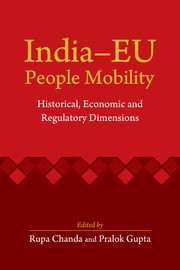Book contents
- Frontmatter
- Dedication
- Contents
- List of Tables, Figures and Boxes
- List of Abbreviations
- Preface
- Acknowledgements
- 1 India–EU People Mobility: Present Status and Policy Perspective
- 2 Economic Linkages and India–EU Mobility
- 3 Indian Diaspora in the EU
- 4 Goans in Portugal: History, Identity and Diaspora Linkages
- 5 Facilitating India–EU Mobility of IT Professionals
- 6 Movement of Indian Architects and Engineers: Prospects and Challenges in the EU
- 7 Mobility of Indian Legal Professionals to the EU: Understanding the EU's Regulatory Regime
- 8 Exploring India–EU Student Mobility
- 9 The Way Forward to a Strategic Engagement
- Contributors
- Index
5 - Facilitating India–EU Mobility of IT Professionals
Published online by Cambridge University Press: 05 January 2016
- Frontmatter
- Dedication
- Contents
- List of Tables, Figures and Boxes
- List of Abbreviations
- Preface
- Acknowledgements
- 1 India–EU People Mobility: Present Status and Policy Perspective
- 2 Economic Linkages and India–EU Mobility
- 3 Indian Diaspora in the EU
- 4 Goans in Portugal: History, Identity and Diaspora Linkages
- 5 Facilitating India–EU Mobility of IT Professionals
- 6 Movement of Indian Architects and Engineers: Prospects and Challenges in the EU
- 7 Mobility of Indian Legal Professionals to the EU: Understanding the EU's Regulatory Regime
- 8 Exploring India–EU Student Mobility
- 9 The Way Forward to a Strategic Engagement
- Contributors
- Index
Summary
Introduction
Over the past few decades, international off-shoring of services has grown considerably. Among the developing countries, India has become a major outsourcing hub on account of its proficient, technically skilled and cost-effective human capital base (Ghibutiu and Dumitriu, 2008). Information technology (IT) and IT-enabled services (ITeS) constitute the bulk of India's services exports and a large part of IT/ITeS exports are directed towards developed markets such as the United States (US) and the European Union (EU).
In fact, India and the EU are two key players in global IT/ITeS trade. In India, clients from the EU (particularly the United Kingdom) dominate the sector. With the high and growing demand for IT/ITeS services, the trend in offshoring from the EU to India is expected to continue (Palugod and Palugod, 2011). The IT–ITeS sector is skill-intensive and dependent on the availability of quality and educated manpower. There is growing demand for high-skilled IT professionals in the EU, which is facing a shortage of labour due to its ageing population (European Commission, 2006). India with its young and qualified manpower complements this growing skill requirement in the EU. These mutual complementarities have led to increased cross-border movement of IT–ITeS professionals, especially Indian professionals to the EU, and the presence of Indian and EU companies in each other's territories (Chanda, 2008).
Against this backdrop, this chapter examines the flow of IT professionals between India and the EU. It identifies the barriers in both markets and suggests how they can be addressed through domestic reforms, mutual collaboration and bilateral trade agreements such as the ongoing India–EU Broad-based Trade and Investment Agreement (BTIA). The structure of this chapter is as follows: The second section provides an overview of the IT–ITeS sector in India and the EU and the third section examines the governance structure and regulation. Section 4 focuses on bilateral trade and labour mobility between India and the EU in this sector, based on secondary information. The fifth section examines the pattern and trends in labour mobility in the IT–ITeS sector between the two sides, based on a primary survey. It also discusses the barriers to movement of professionals between India and the EU. The concluding section provides policy recommendations and the way forward to facilitate the mobility of IT professionals between the two.
- Type
- Chapter
- Information
- India–EU People MobilityHistorical, Economic and Regulatory Dimensions, pp. 117 - 141Publisher: Cambridge University PressPrint publication year: 2015



